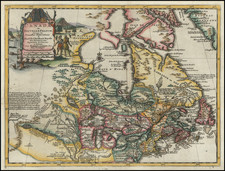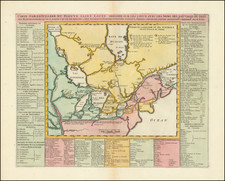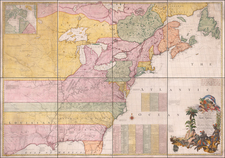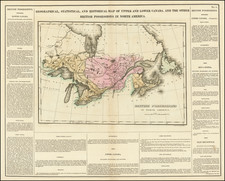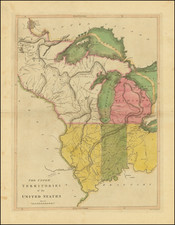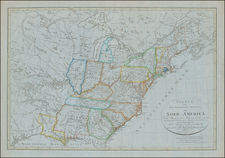Unrecorded Mammoth Map of Hyde Park Township
Remarkable oversized map of Hyde Park Township, illustrating the township and its drainage system, prepared using the topographical survey completed in 1883-84.
This would also seem to be one of the earliest surviving maps of all of Hyde Park. Will several smaller maps illustrate portions of the Township, we find not other Hyde Park maps in OCLC which cover the entire township.
The map identifies streets, parks, railroad lines, Calumet Lake, Calumet River, Kake Hyde, Lake Wolf, The United States Rolling Stock Co.'s Shops, Brown Iron & Steel Works, Washington Ice Compnay and a number of train stations.
This without question the largest and one of the earliest maps of Hyde Park, published 5 years before Hyde Park became part of the City of Chicago and 6 years before the University of Chicago relocated its campus to Hyde Park in 1890.
Hyde Park History
In 1853, Paul Cornell, a real estate speculator and cousin of Cornell University founder Ezra Cornell, purchased 300 acres between 51st and 55th streets along the shore of Lake Michigan. The land was located seven miles south of Downtown Chicago in a rural area that enjoyed weather tempered by the lake - cooler in the summer and warmer in the winter. It was conveniently located near the Illinois Central Railroad, which had been constructed two years earlier. Cornell successfully negotiated land in exchange for a railroad station at 53rd Street. Hyde Park quickly became a popular suburban retreat for affluent Chicagoans who wanted to escape the noise and congestion of the rapidly growing city.
In 1857, the Hyde Park House, an upscale hotel, was built on the shore of Lake Michigan near the 53rd Street railroad station. For two decades, the Hyde Park House served as a focal point of Hyde Park social life. During this period, it was visited or lived in by many prominent guests, including Mary Todd Lincoln, who lived there with her children for two and a half months in the summer of 1865 (shortly after her husband was assassinated). The Hyde Park House burned down in an 1879 fire. The Sisson Hotel was built on the site in 1918 and was eventually converted into a condominium building (the Hampton House).
In 1861, Hyde Park was incorporated as an independent township (called Hyde Park Township). Its boundaries were Pershing Road (39th Street) on the north, 138th Street on the south, State Street on the west, and Lake Michigan and the Indiana state line on the east. The territory of the township encompassed most of what is now the South Side of Chicago. Hyde Park Township remained independent of Chicago until it was annexed to the city in 1889. After annexation, the definition of Hyde Park as a Chicago neighborhood was restricted to the historic core of the former township, centered on Cornell's initial development between 51st and 55th streets near the lakefront.
Rarity
The map is unrecorded. We locate no examples at auction or in any dealer catalog or institutional collection.
Rand McNally & Co. is a large American map and navigation company best known for its annual atlases. The company got its start in 1856, when William Rand opened a print shop in Chicago. He was joined in 1858 by a new employee, Andrew McNally. Together, the men established their namesake company in 1868. Originally, the company was intended to print the tickets and timetables for the trains running to and through Chicago; their first railway guide was published in 1869.
By 1870, they had shifted from just printing to publishing directories, travel guides, and newspapers. Their first map appeared in 1872 in a railway guide. The map was produced using a new wax engraving method, a cheaper process that gave the company an edge.
By 1880 Rand McNally had entered the education market with globes, wall maps, and geography texts for students. In 1923, Rand McNally published the first Goode’s World Atlas, named after its editor, Dr. J. Paul Goode. For generations afterward, this would be the standard classroom atlas.
In 1899, William Rand left the company, but McNally and his family remained, controlling the company for over a century. In 1904, they published their first road map intended for automobiles and by 1907 were publishing Photo-Auto Guides, which combined photography and mapping to help drivers. In 1924, they produced the Auto Chum, a precursor to their famous road atlases. Rand McNally would remain the leader in road maps and atlases throughout the twentieth century.
In 1937, Rand McNally opened its first store in New York City. Ever on the frontier of technology, Rand McNally pioneered the scribing process for printing tickets in 1958 and printed their first full-color road atlas in 1960. Arthur Robinson developed his now-famous projection of Rand McNally in 1969. By the 1980s, the company was exploring digital reproduction and digital databases of maps for truckers. In the 1990s, they lead the charge to develop trip-planning software and websites. Today, most of its products are available online or in a digital format, including maps for tablets and phones.









